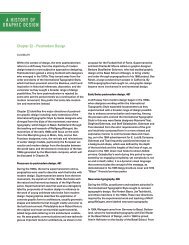Week 9 Graphic Design and the Industrial Revolution - A History of ...
Week 9 Graphic Design and the Industrial Revolution - A History of ...
Week 9 Graphic Design and the Industrial Revolution - A History of ...
- No tags were found...
Create successful ePaper yourself
Turn your PDF publications into a flip-book with our unique Google optimized e-Paper software.
A HISTORY OFGRAPHIC DESIGN<strong>of</strong>ten contradictory design approaches <strong>and</strong> philosophies mixed toge<strong>the</strong>r in a scattered fashion (Fig. 9-47).Great Exhibition or Crystal Palace Exhibition <strong>of</strong> 1851, page 162, , a gr<strong>and</strong> exhibition with hundreds <strong>of</strong> exhibitors from all<strong>the</strong> industrialized nations, was conceived in 1849 by Prince Albert, husb<strong>and</strong> <strong>of</strong> Queen Victoria. Set in an 800,000-squarefootsteel <strong>and</strong> glass prefabricated exhibition hall that remains a London l<strong>and</strong>mark in architectural design, <strong>the</strong> exhibitionwas an important summation <strong>of</strong> <strong>the</strong> progress <strong>of</strong> <strong>the</strong> <strong>Industrial</strong> <strong>Revolution</strong> <strong>and</strong> a catalyst for future developments.Lithography, page 162, “stone printing,” invented by Bavarian author Aloys Senefelder in 1796. Based on <strong>the</strong> simplechemical principle that oil <strong>and</strong> water do not mix, an image is drawn on a flat stone surface with an oil-based medium.Water is <strong>the</strong>n spread over <strong>the</strong> stone to moisten all areas except <strong>the</strong> oil-based image, which repels <strong>the</strong> water <strong>and</strong> acceptsoil-based ink, which is <strong>the</strong>n transferred to paper.Planographic printing, page 163, printing from a flat surface.Chromolithographie, page 163, patented by French printer Godefroy Engelmann, <strong>the</strong> printer separated <strong>the</strong> colors froman image into a series <strong>of</strong> printing plates <strong>and</strong> printed <strong>the</strong>se component colors one by one. One printing plate (<strong>of</strong>ten black)established <strong>the</strong> image after separate plates printed o<strong>the</strong>r colors.Rotary lithographic press, page 163, perfected by Richard M. Hoe, nicknamed “<strong>the</strong> lightning press” because it couldprint six times as fast as <strong>the</strong> lithographic flatbed presses <strong>the</strong>n in use.L. Prang <strong>and</strong> Company, page 164, Louis Prang’s company name after he bought partner Julius Mayer’s share.Scrap, page 164, printed album cards produced by Louis Prang. Collecting <strong>the</strong>se “beautiful art bits” was a major Victorianpastime, <strong>and</strong> Prang’s wildflowers, butterflies, children, animals, <strong>and</strong> birds became <strong>the</strong> ultimate expression <strong>of</strong> <strong>the</strong>period’s love for sentimentalism, nostalgia, <strong>and</strong> traditional values.Toy books, page 168, colorful picture books for preschool children made during <strong>the</strong> Victorian Era (Fig. 9-65).Harper <strong>and</strong> Bro<strong>the</strong>rs, page 170, <strong>the</strong> New York company started by James <strong>and</strong> John Harper that became <strong>the</strong> largestprinting <strong>and</strong> publishing firm in <strong>the</strong> world by <strong>the</strong> middle <strong>of</strong> <strong>the</strong> nineteenth century. They launched a monumental projectthat became <strong>the</strong> young nation’s finest achievement <strong>of</strong> graphic design <strong>and</strong> book production (up until that time) calledHarper’s Illuminated <strong>and</strong> New Pictorial Bible. Printed on presses specially designed <strong>and</strong> built for its production, it contained1,600 wood engravings from illustrations by Joseph A. Adams. The firm opened <strong>the</strong> era <strong>of</strong> <strong>the</strong> pictorial magazinein 1850 when <strong>the</strong> 144-page Harper’s New Monthly Magazine began publication. The monthly magazine was joined by aweekly periodical that functioned as a newsmagazine, Harper’s <strong>Week</strong>ly, along with Harper’s Bazaar for women in 1867,<strong>and</strong> Harper’s Young People in 1879 (Fig. 9- 69).Harper’s New Monthly Magazine, page 171, a 144-page pictorial magazine started in 1850 with serialized English fiction<strong>and</strong> numerous woodcut illustrations created for each issue by <strong>the</strong> art staff (Fig. 9-69).Harper’s <strong>Week</strong>ly, page 171, a weekly periodical that functioned as a newsmagazine; it billed itself as “a journal <strong>of</strong> civilization”<strong>and</strong> developed an elaborate division <strong>of</strong> shop labor for <strong>the</strong> rapid production <strong>of</strong> woodblocks for printing cartoons<strong>and</strong> graphic reportage based on drawings from artist-correspondents (Fig. 9-70).Harper’s Bazaar, page 171, a magazine focused on women founded in 1867.Harper’s Young People, page171, a magazine focused on <strong>the</strong> youth audience founded in 1879.MacKellar, Smiths & Jordan Foundry, page 175, became a major component <strong>of</strong> <strong>the</strong> American Type Founders Companywhen <strong>the</strong> monopoly was formed in 1892. It played a significant role in <strong>the</strong> design <strong>and</strong> production <strong>of</strong> Victorian displaytypefaces; Herman Ihlenburg was a leading member <strong>of</strong> <strong>the</strong>ir design staff (Fig. 9-75).
















